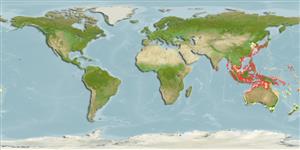>
Acanthuriformes (Surgeonfishes) >
Lobotidae (Tripletails)
Etymology: Hapalogenys: Greek, hapalos = soft * Greek, geny, -yos = face (Ref. 45335).
More on authors: Smith & Pope.
Issue
Family placement uncertain.
Environment: milieu / climate zone / depth range / distribution range
Ecologia
marino benthopelagico. Tropical
Western Pacific: southern Japan (except Ryukyus) to northwestern Australia (Ref. 36944).
Size / Peso / Age
Maturity: Lm ? range ? - ? cm
Max length : 33.8 cm SL maschio/sesso non determinato; (Ref. 36944)
Spine dorsali (totale) : 11; Raggi dorsali molli (totale) : 14; Spine anali: 3; Raggi anali molli: 8 - 9. Body with 4 - 5 longitudinal dark stripes, sometimes with 1 vertical dark band on caudal peduncle. Apparent procumbent spinelike process. No scales on maxilla. Ten chin pores, often slitlike pores posteriorly. Poorly developed papillae and barbels on the fleshy lower lip. No dark margin on dorsal, caudal and anal fins (Ref. 36944).
Inhabits sandy and muddy areas in coastal waters (Ref. 9137, 11230).
Life cycle and mating behavior
Maturities | Riproduzione | Spawnings | Egg(s) | Fecundities | Larve
Iwatsuki, Y. and B.C. Russell, 2006. Revision of the genus Hapalogenys (Teleostei: Perciformes) with two new species from the Indo-West Pacific. Mem. Mus. Victoria 63(1):29-46. (Ref. 76777)
IUCN Red List Status (Ref. 130435)
Threat to humans
Harmless
Human uses
Pesca: commerciale
Strumenti
Special reports
Download XML
Fonti Internet
Estimates based on models
Preferred temperature (Ref.
123201): 20.7 - 28.8, mean 27.5 °C (based on 564 cells).
Phylogenetic diversity index (Ref.
82804): PD
50 = 0.5078 [Uniqueness, from 0.5 = low to 2.0 = high].
Bayesian length-weight: a=0.01862 (0.00830 - 0.04177), b=3.01 (2.81 - 3.21), in cm total length, based on LWR estimates for this (Sub)family-body shape (Ref.
93245).
Trophic level (Ref.
69278): 4.0 ±0.65 se; based on food items.
Resilienza (Ref.
120179): Alto, tempo minimo di raddoppiamento della popolazione meno di 15 mesi (Preliminary K or Fecundity.).
Fishing Vulnerability (Ref.
59153): Low to moderate vulnerability (31 of 100).
